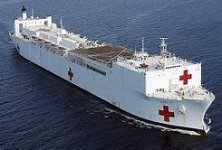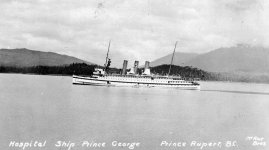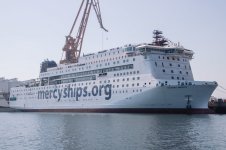Hospital ships are excellent vehicles of international policy, diplomacy and humanitarian efforts. They can provide humanitarian assistance during disasters, advanced medical treatment, services and on-board medical training. These ships are internationally protected in accordance with Protocol 1 of the Geneva Conventions of 1949. In a domestic environment, hospital ships can augment or replace provincial medical infrastructure during disasters, and provide alternate treatment facilities and hospital beds during an outbreak of highly infectious pathogens such as the current COVID-19 crisis. Furthermore, Canadian hospital ships could contribute to Canadian development and expansion in the Arctic by providing advanced medical care to remote, medically underserved, northern communities.
Unlike field hospitals or deployable emergency response units such as Canada’s Disaster Assistance Response Teams (DART), hospital ships require little in terms of support from ashore, are relatively easy to support logistically, and are inherently mobile. They are capable of deploying domestically or world-wide and are self-sufficient when they reach their destinations. Further, hospital ships (and embarked patients and staff) can easily be moved in the face of natural or man-made threats. Hospital ships can be pre-positioned to areas such as the Caribbean during hurricane season in the same way that Canada currently deploys its warships. Hospital ships provides their own power, air conditioning, heat, fresh water, food, medical oxygen, stores and medical supplies as well as safe, comfortable and secure accommodations and workspaces for medical staff. They can accommodate advanced medical diagnostic equipment such as MRIs, CT Scans, X-ray equipment, surgical suites, etc., and operate advanced medical equipment in controlled environmental conditions.
When not deployed, hospital ships can be maintained by skeleton crews while medical staff return to their primary employment. When deployed, medical staff for these ships can be drawn from a variety of sources such as contracted medical personnel, volunteers, non-governmental organizations, as well as from the Canadian Forces medical services. Medical staff can be flown to meet Canadian forward deployed hospital ships, when activated by the Canadian government. Medical personnel can be rotated in and out of theatre as required, thus allowing more opportunities for medical professionals to find time to serve on board.
There are only three countries in the world that operate ‘dedicated’ hospital ships: the United States, China and Russia. Britain is seriously considering building their own dedicated Hospital ship as well. The use of USNS Comfort and Mercy deployed to both Los Angeles and New York during the current COVID-19 pandemic have been a useful and a much-needed response. In 2005 the U.S. deployed both hospital ships, to New Orleans in the wake of Hurricane Katrina to provide alternate advanced medical capabilities to those facilities that were damaged in the hurricane. USNS Mercy was also deployed as well after 9/11, to supplement the existing medical infrastructure in New York City. China and the United States worked together to deploy their hospital ships to the Philippines after Typhoon Haiyan in 2013 and the United States deployed one to Haiti after the 2010 earthquake and to Aceh, Indonesia after the 2004 tsunami. Great Britain deployed its ‘converted’ Royal Fleet Auxiliary Casualty Reception Ship RFA Argus, to Sierra Leone in 2015 in response to the Ebola outbreak in West Africa.
It begs the question, could Canada have used these kind of relief ships as well? Most hospital ships began their lives in other roles. USN Ships Comfort and Mercy were built as USN oil tankers before undergoing conversion. While new-build Canadian hospital ships are certainly within the capabilities of the Canadian shipbuilding industry, conversion of existing commercial ship designs might prove to be the most cost-effective alternative. Currently, there are a number of relatively new and inexpensive cruise, container and tanker ships available for sale or lease on the commercial market that could easily be converted into modern hospital ship designs. Several Canadian shipyards have the capacity to convert these ships into “dedicated” hospital ships.
Hospital ship projects such as the "Global Mercy Hospital Ship" just completed in China and now being outfitted in Belgium could be built here in Canada and have regional benefits for shipyards and included in our National Shipbuilding Strategy (NSS). Much of the specialized medical equipment could be sourced through Canadian companies, contributing to the Canadian economy. So, given the inherent value of national assets like dedicated hospital ships, their contribution to Canada’s ability to project soft power, the ability to contribute to Canadian international development and humanitarian assistance/disaster relief response during crises, and their affordability, Canada should seriously consider acquiring such dedicated hospital ships for domestic and humanitarian response.
Unlike field hospitals or deployable emergency response units such as Canada’s Disaster Assistance Response Teams (DART), hospital ships require little in terms of support from ashore, are relatively easy to support logistically, and are inherently mobile. They are capable of deploying domestically or world-wide and are self-sufficient when they reach their destinations. Further, hospital ships (and embarked patients and staff) can easily be moved in the face of natural or man-made threats. Hospital ships can be pre-positioned to areas such as the Caribbean during hurricane season in the same way that Canada currently deploys its warships. Hospital ships provides their own power, air conditioning, heat, fresh water, food, medical oxygen, stores and medical supplies as well as safe, comfortable and secure accommodations and workspaces for medical staff. They can accommodate advanced medical diagnostic equipment such as MRIs, CT Scans, X-ray equipment, surgical suites, etc., and operate advanced medical equipment in controlled environmental conditions.
When not deployed, hospital ships can be maintained by skeleton crews while medical staff return to their primary employment. When deployed, medical staff for these ships can be drawn from a variety of sources such as contracted medical personnel, volunteers, non-governmental organizations, as well as from the Canadian Forces medical services. Medical staff can be flown to meet Canadian forward deployed hospital ships, when activated by the Canadian government. Medical personnel can be rotated in and out of theatre as required, thus allowing more opportunities for medical professionals to find time to serve on board.
There are only three countries in the world that operate ‘dedicated’ hospital ships: the United States, China and Russia. Britain is seriously considering building their own dedicated Hospital ship as well. The use of USNS Comfort and Mercy deployed to both Los Angeles and New York during the current COVID-19 pandemic have been a useful and a much-needed response. In 2005 the U.S. deployed both hospital ships, to New Orleans in the wake of Hurricane Katrina to provide alternate advanced medical capabilities to those facilities that were damaged in the hurricane. USNS Mercy was also deployed as well after 9/11, to supplement the existing medical infrastructure in New York City. China and the United States worked together to deploy their hospital ships to the Philippines after Typhoon Haiyan in 2013 and the United States deployed one to Haiti after the 2010 earthquake and to Aceh, Indonesia after the 2004 tsunami. Great Britain deployed its ‘converted’ Royal Fleet Auxiliary Casualty Reception Ship RFA Argus, to Sierra Leone in 2015 in response to the Ebola outbreak in West Africa.
It begs the question, could Canada have used these kind of relief ships as well? Most hospital ships began their lives in other roles. USN Ships Comfort and Mercy were built as USN oil tankers before undergoing conversion. While new-build Canadian hospital ships are certainly within the capabilities of the Canadian shipbuilding industry, conversion of existing commercial ship designs might prove to be the most cost-effective alternative. Currently, there are a number of relatively new and inexpensive cruise, container and tanker ships available for sale or lease on the commercial market that could easily be converted into modern hospital ship designs. Several Canadian shipyards have the capacity to convert these ships into “dedicated” hospital ships.
Hospital ship projects such as the "Global Mercy Hospital Ship" just completed in China and now being outfitted in Belgium could be built here in Canada and have regional benefits for shipyards and included in our National Shipbuilding Strategy (NSS). Much of the specialized medical equipment could be sourced through Canadian companies, contributing to the Canadian economy. So, given the inherent value of national assets like dedicated hospital ships, their contribution to Canada’s ability to project soft power, the ability to contribute to Canadian international development and humanitarian assistance/disaster relief response during crises, and their affordability, Canada should seriously consider acquiring such dedicated hospital ships for domestic and humanitarian response.
Attachments
Last edited:







